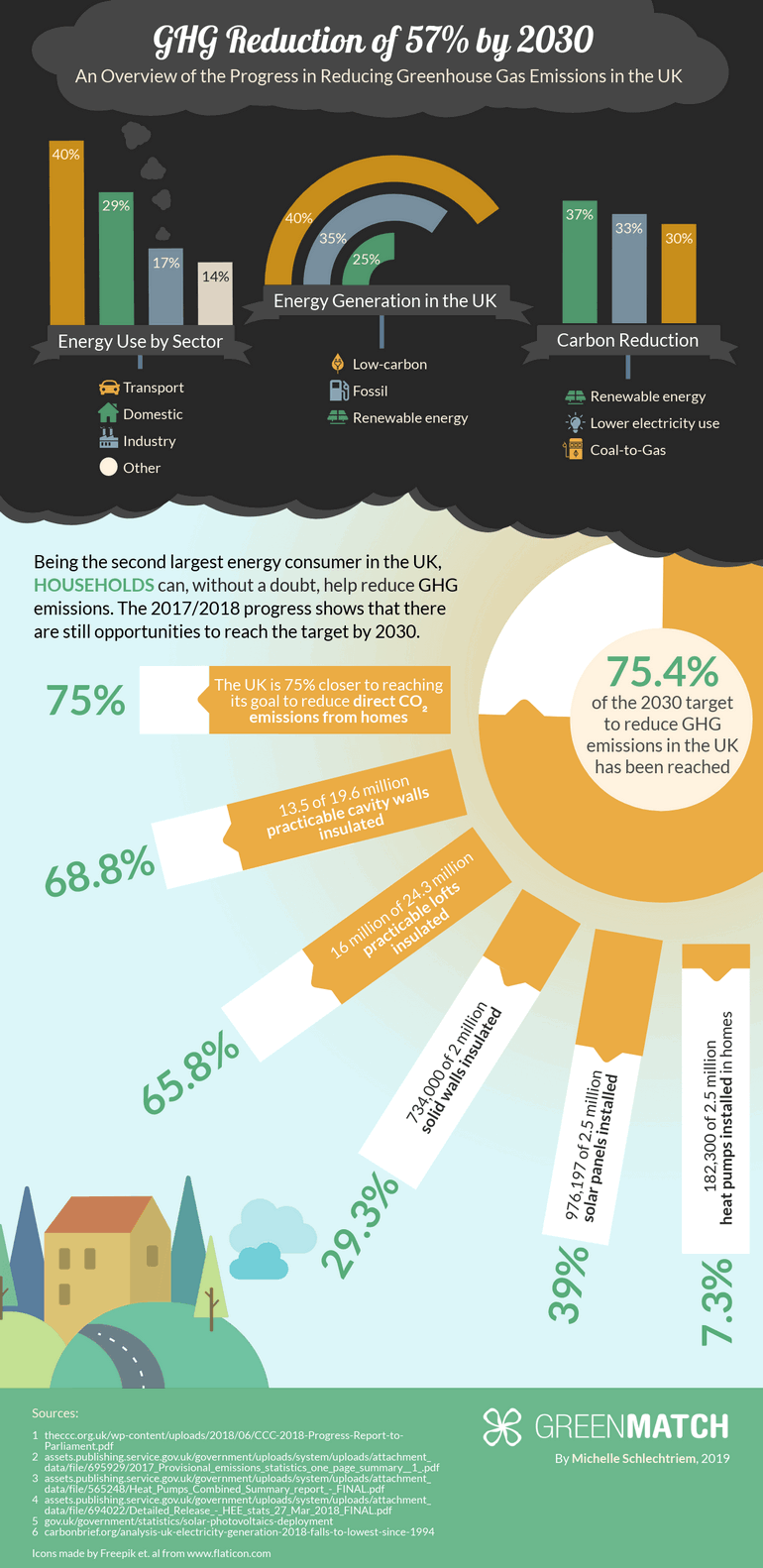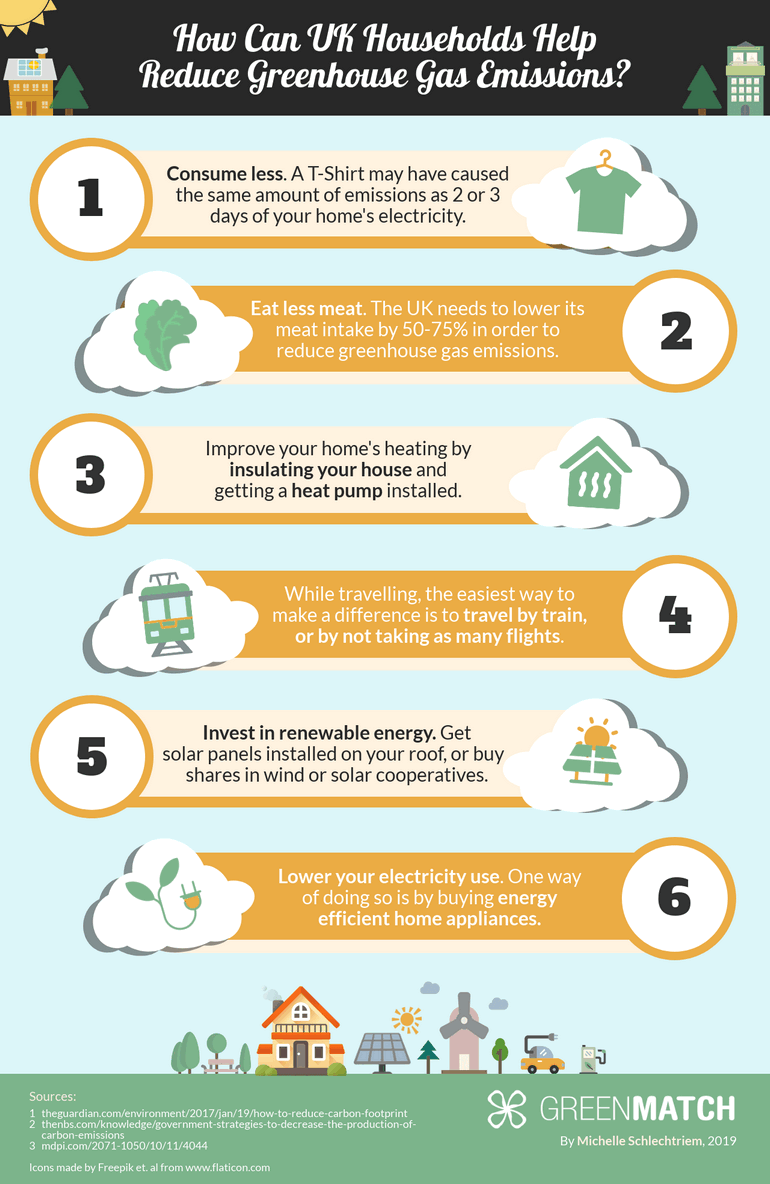- GreenMatch
- Blog
- Households Fight Greenhouse Gas Emissions
Households Fight Greenhouse Gas Emissions

UK’s Greenhouse Gas (GHG) Emissions Today
The most recent data has shown that the electricity generation in the UK in 2018 was the lowest since 1994. More specifically, the current amount of electricity generated per person is the lowest since 1984, having fallen by 24% since 2005.
Other recent data from the government has revealed a 2.7% drop in UK GHG emissions in 2017, compared to the previous year. This has largely been thanks to warmer winters and the ongoing coal-to-gas switch by the national grid.
Therefore, a key factor in reducing GHG emissions is reducing the amount of electricity that is being generated. 2017 saw a 4.2% cut in GHGs from the residential sector, thanks to a reduction in the use of natural gas for domestic heating.
Since 2012, 75% of the reduction of GHG emissions has come from the electric power sector. However, the other sectors — transport, buildings, agriculture, waste, and fluorinated gases — have barely changed, even though transportation and domestic buildings make up for most of the UK’s energy consumption. Hence, it is now important to focus on the other sectors too. Check our latest analysis concerning greenhouse gas emission in EU countries
Domestic Energy Consumption in the UK
Domestic households make up for 29% of the energy generation in the UK. Consequently, UK households accounted for one quarter of the total GHGs in the UK, making them the biggest emitter in 2016.
In 2018, electricity in the UK was generated through three types of fuel sources: low-carbon, fossil, and renewable energy, with the latter accounting for 25% of the total. Both renewable energy and energy efficiency are key elements on the pathway to meeting the UK’s targets for reducing GHG emissions.
Targets for Lowering GHG Emissions by 2030
The Committee on Climate Change has set specific goals for 2030. Their main goal is to reduce GHG emissions in the UK by 57% before the end of the upcoming decade. So far, the UK’s GHG emissions have been reduced by 43% when comparing to 1990 levels.
Since domestic households are the second largest energy consumer in the UK, it is reasonable to expect their help in achieving these 2030 goals. The infographic below highlights the targets that are set for lowering GHGs in UK households.

If you would like to use this infographic on your website, use the embed code below:
Progress towards the 2030 Goals
The UK government has revealed data from 2017, which shows that direct CO2 emissions from homes in the UK have decreased by 18% since 1990. This is partially thanks to UK households having a total of 182,300 heat pumps, and 976,197 solar panels, installed by 2017.
UK houses mainly have cavity walls and lofts practicable for insulation. The majority of these houses already had been insulated by 2017. However, the target for 2030 is to have all of these cavity walls and lofts in the UK insulated, so there is still some work left to do.
Moreover, the Committee on Climate Change has set a target for solid walls too. So far, only 734,000 solid walls have been insulated in the UK, whereas the target for 2030 is set at two million insulations.
Key Factors in Reducing GHG Emissions in the UK
In 2017 the reduction of CO2 emissions had mainly come from the use of green energy. 37% of the CO2 reduction in the UK was thanks to renewable energy in the form of wind energy (20%), bioenergy (12%), and solar energy (5%).
Another key factor was the lower electricity usage, accounting for 33%. As mentioned above, the electricity generation in the UK in 2018 was the lowest since 1994. This is mainly thanks to an increase in energy efficiency and environmental consciousness in society.
In the summer of 2018, the UK experienced its first day without coal-fired power in the last 130 years. Moreover, power generation from coal in the UK has fallen from 25% in 2014 to a mere 2% in 2017. Consequently, the coal-to-gas switch has significantly helped to reduce GHG emissions, accounting for 29% in 2017.
How UK Households Can Help to Reduce GHG Emissions
There are various ways in which households can help reduce GHG emissions in the UK. One of the main facts is that, in order to prevent global warming above 1.5 degrees, we have to leave 80% of our fossil fuels in the ground.

If you would like to use this infographic on your website, use the embed code below:
Another key factor to help reduce GHGs is to to be more aware of the environmental consequences of our consumption behaviour. For example, the carbon footprint of a piece of woolen clothing may be just as high as your home’s electricity use for an entire month
Lowering your meat intake could have a tremendous impact on GHG emissions on a global scale. To be specific, a vegan diet could reduce your dietary carbon footprint by up to 73%. Simply cutting out beef and lamb from your diet could already make a significant change, as this agricultural production generates the most emissions.
Furthermore, you can significantly reduce your energy usage by buying energy efficient appliances, by insulating your home through, for example, double glazed windows, or by switching to low carbon heating such as air source heat pumps (ASHP). This will not only lower your energy bills but it will also reduce your carbon footprint.
If you are a frequent traveller, the easiest way for you to make a difference is to travel by train or to simply not take as many flights. Depending on the type of the train and the distance you are travelling, train journeys in Europe release around 90% less CO2 than plane journeys.
Besides, if you are a frequent driver, try to reduce the distance you drive, and consider an electric vehicle. Even though the electricity generation will come from gas or coal, their efficiency will still help to reduce CO2 emissions.
Last but not least, solar energy is the most environmental-friendly source of energy as it doesn’t produce any GHGs. Investing in renewable energy, such as solar panels, has therefore huge benefits for the environment — as well as your bills!

Valli has been writing well researched articles about renewable energy, sustainability and green technologies for GreenMatch since 2017. Her work has been published in various media such as Entrepreneur, Business Insider, Canadian Geographic, uSwitch, and eCycle.
We strive to connect our customers with the right product and supplier. Would you like to be part of GreenMatch?





